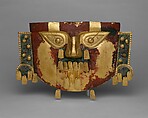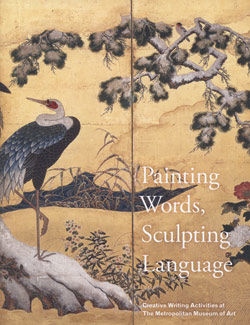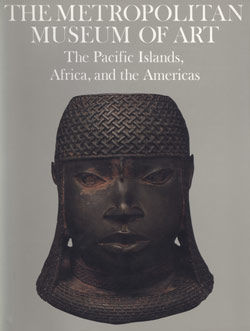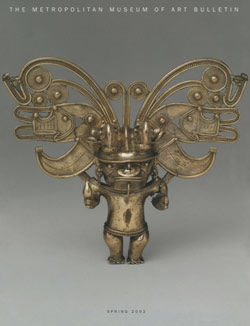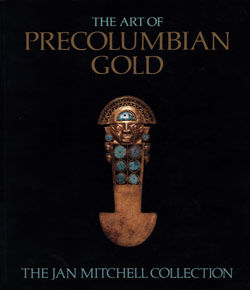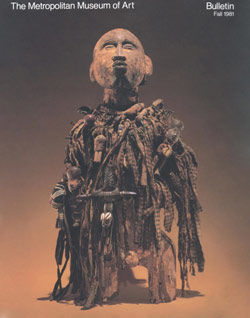Funerary mask
Not on view
This mask, made of hammered sheet gold alloy and covered in red pigment, once adorned the body of a deceased ruler on Peru’s north coast. Powerful dynasties arose in this region between the eighth and the fourteenth centuries A.D. and amassed great riches in gold and silver before they were conquered by the Inca Empire in the late fifteenth century. The lords of these dynasties were the patrons of vast workshops where finely crafted ornaments and ceremonial vessels were created (see 1991.419.62; 66.196.27). At death, the lords were buried deep in monumental mud-brick platform mounds along with large numbers of objects of precious metal, shell, and cloth. In addition to beakers, disks, and other ornaments, the burials included large masks made of sheet gold. As many as five masks were placed into one burial: one attached to the head of the textile-wrapped body, and the other four stacked at the feet of the deceased.
This mask was made of an alloy of 74 percent gold, 20 percent silver, and 6 percent copper which was then hammered into a sheet and shaped into the form of a face. Interestingly, cinnabar, a red mineral pigment, covers much of the cheeks and forehead of this mask, obscuring the gold surface. The cinnabar may emulate the patterning of face paint worn by individuals of importance: according to early colonial accounts a courtier was charged with the task of maintaining such paints. Faint traces of the textile wrappings that once enveloped the mummy bundle can be detected in impressions on the red paint. Masks in museum collections are often missing such surface embellishment (see 1979.206.556), as the pigment would have been removed in modern times to highlight the golden substrate. The eyes of this mask have thin, skewer-like projections emerging from the pupils, perhaps suggesting powerful or even piercing vision. In other masks these projections include small beads of amber and emerald, which have led scholars to interpret the projections as tears. On the ears and ear ornaments can be seen restored examples of the silver-surfaced overlays (now corroded green) that would have also been originally present attached to the mask. Further surface additions include danglers on the U-shaped nose ornament. Such spangles would have caught the light of the bright sun and conveyed a sense of movement and life as a mummy bundle was conveyed to its final resting place.
Masks such as these, with their characteristic ovoid eyes terminating in a point, are associated with the Lambayeque culture, named for a region near the modern city of Chiclayo on Peru’s north coast. This polity, also known as Sicán, erected great monumental centers such as Batán Grande, Chornancap, and other sites. Recent excavations at Chornancap by Carlos Wester and his team have revealed that such masks were part of the burial regalia of high-status women as well as men. According to myths on the north coast, gold was particularly associated with male rulers, silver with noble women, and copper with commoners. A mask from Chornancap, found in the tomb of an importance priestess, was made of silver.
The pointed ovoid eyes on this mask and others, sometimes referred to as winged eyes, have been identified as defining features of a being known as the Sicán Deity. According to Izumi Shimada and colleagues, an individual interred with such a mask would have been thought to take on aspects of the Sicán Deity’s power, and would have been transformed into a venerated ancestor upon death.
Joanne Pillsbury, Andrall E. Pearson Curator
2015
Published references
Jones, Julie, and Heidi King. Gold of the Americas. New York: The Metropolitan Museum of Art, 2002, pp. 36-37.
King, Heidi, Rain of the Moon: Silver in Ancient Peru. With contributions by Luis Jaime Castillo Butters and Paloma Carcedo de Mufarech. New York: Metropolitan Museum of Art; [New Haven, Conn.]: Yale University Press, 2000, p. 21, fig. 8.
Mackey, Carol J. and Joanne Pillsbury. “Cosmology and Ritual on a Lambayeque Beaker,” in Margaret Young-Sánchez, ed., Pre-Columbian Art & Archaeology: Essays in Honor of Frederick R. Mayer, pp. 115-141. Denver: Denver Art Museum, 2013; p. 120, fig. 6.
Shimada, Izumi, “Behind the Golden Mask: Sicán Gold Artifacts from Batán Grande, Peru,” in Julie Jones, ed., The Art of Precolumbian Gold: The Jan Mitchell Collection. Boston: Little Brown, 1985, pp. 60-75; fig. 6.
Further reading
Elera, Carlos G., “The Face Behind the Mask,” in Victor Pimentel, ed., Peru: Kingdoms of the Sun and Moon, pp. 96-105 (Montreal: Montreal Museum of Fine Arts, 2013).
Hildebrand, Joyce, Karen Buckley eds. Ancient Peru Unearthed: Golden Treasures of a Lost Civilization. Exh. cat. Calgary: The Nickle Arts Museum, University of Calgary Press, 2006.
Jones, Julie ed., The Art of Precolumbian Gold: The Jan Mitchell Collection. Boston: Little Brown, 1985.
Shimada, Izumi, ed., Cultura Sicán: Esplendor preincaico de la costa norte. Translated by Gabriela Cervantes. Lima: Fondo Editorial del Congreso del Perú, 2014.
Shimada, Izumi, Cultura Sicán: Dios, riqueza y poder en la costa norte del Perú (Lima: Fundación del Banco Continental para el Fomento de la Educación y la Cultura, Edubanco, 1995).
Shimada, Izumi, and Jo Ann Griffin. “Precious Metal Objects of the Middle Sican.” Scientific American (April 2004), pp. 80-89.
Shimada, Izumi, Jo Ann Griffin, and Adon Gordus. “The Technology, Iconography, and Social Significance of Metals: A Multidimensional Analysis of Middle Sicán Objects,” in Colin McEwan, ed., Precolumbian Gold: Technology, Style and Iconography, pp. 28-61. London: The British Museum, 2000.
Shimada, Izumi, Ken-ichi Shinoda, Julie Farnum, Robert S. Corruccini, Hirokatsu Watanabe. “An Integrated Analysis of Pre-Hispanic Mortuary Practices: A Middle Sican Case Study.” Current Anthropology 45, no. 3 (2004), pp. 369-402.
Wester de la Torre, Carlos. Mystery and History in the Lambayeque Culture: The Priestess of Chornancap (Lambayeque: Museo Arqueológico Nacional Brüning, 2013).
Due to rights restrictions, this image cannot be enlarged, viewed at full screen, or downloaded.
